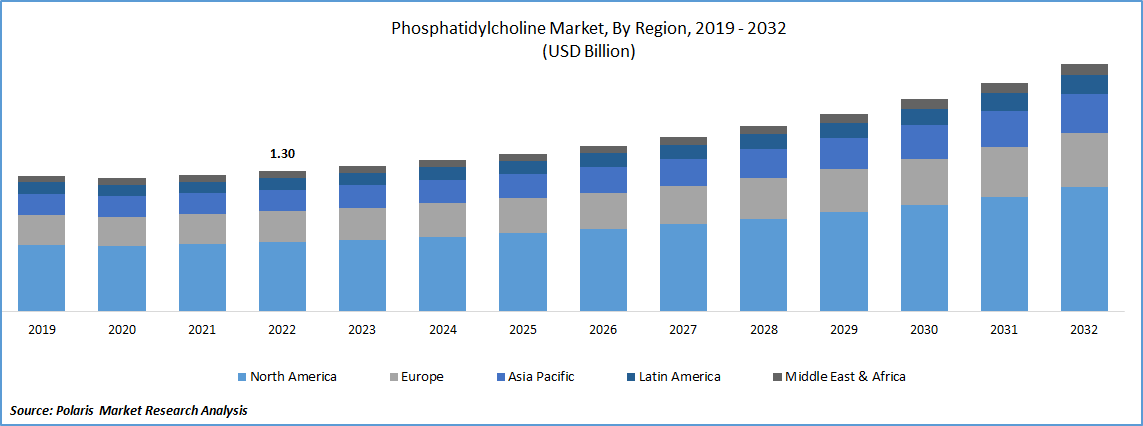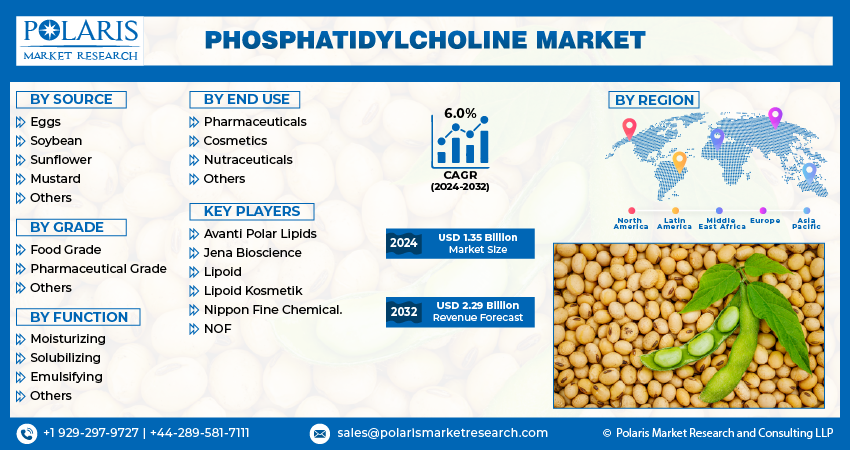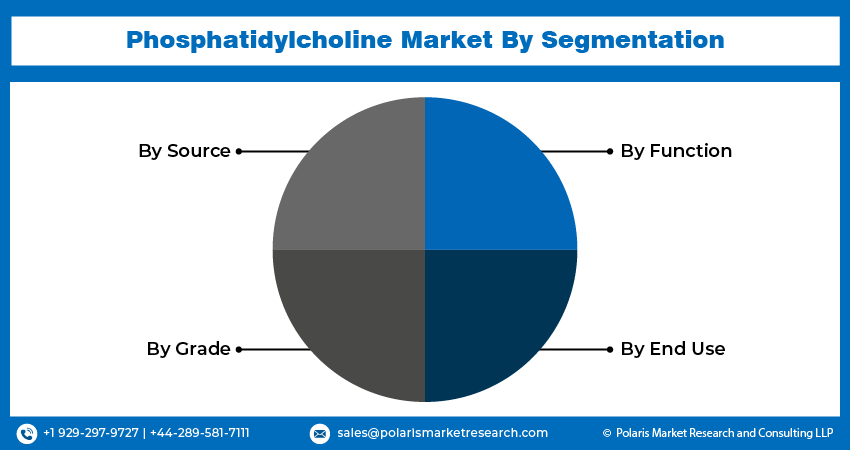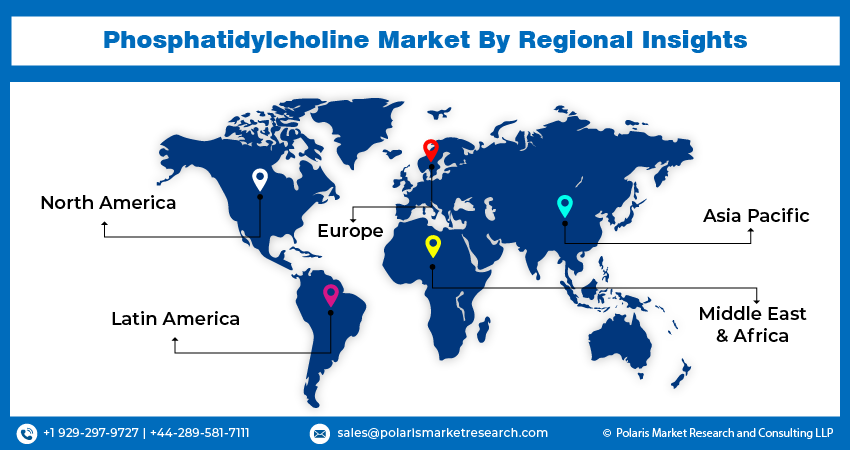
Phosphatidylcholine Market Share, Size, Trends, Industry Analysis Report, By Source (Eggs, Soyabean, Sunflower, Mustard, Others); By Grade; By Function; By End Use; By Region; Segment Forecast, 2023 - 2032
- Published Date:Sep-2023
- Pages: 117
- Format: PDF
- Report ID: PM3755
- Base Year: 2022
- Historical Data: 2019-2021
Report Outlook
The global phosphatidylcholine market was valued at USD 1.3 billion in 2022 and is expected to grow at a CAGR of 6.0% during the forecast period.

To Understand More About this Research: Request a Free Sample Report
Phosphatidylcholine (PC), along with other phospholipids like dipalmitoyl-phosphatidylcholine (DPPC), plays a crucial role as the primary components of lung surfactant. These phospholipids offer unique advantages for pharmaceutical formulations. They are biocompatible, biodegradable, and recognized as safe for delivering drugs to the lungs. For several decades, the administration of phospholipids to the lungs has been successfully employed in treating pathological conditions characterized by insufficient phospholipids in lung tissue, particularly in the alveoli.
One such condition is respiratory distress syndrome (RDS). Pulmonary drug delivery is preferred for locally treating respiratory disorders like RDS, asthma, and chronic obstructive pulmonary disease (COPD). This highlights the significance of phosphatidylcholine and other phospholipids in pulmonary drug delivery. Their properties make them valuable in formulating pharmaceuticals for respiratory conditions and have proven effective in addressing deficiencies of phospholipids in the lungs associated with respiratory distress syndrome and other respiratory disorders.
Industry Dynamics
Growth Drivers
Rising demand for the Phosphatidylcholine
Phosphatidylcholine is a vital phospholipid that plays a fundamental role in maintaining the structure and function of cellular membranes. However, the levels of PC naturally decline as we age, and exposure to factors like injuries, toxins, pollution, pesticides, and poor dietary habits further exacerbate this decrease. The impact of this shift in cellular membrane composition is profound, affecting every cell and organ in the body and impairing overall functionality.
The decline in PC levels and the subsequent increase in sphingomyelin and cholesterol disrupts the delicate balance necessary for optimal cellular homeostasis. This alteration can have far-reaching consequences on cellular processes, signaling, and the overall integrity of cell membranes. The repercussions extend to various bodily functions, hindering human ability to perform optimally. To mitigate these effects and support cellular health, it is crucial to maintain adequate levels of phosphatidylcholine.

Report Segmentation
The market is primarily segmented based on source, grade, function, end use and region.
|
By Source |
By Grade |
By Function |
By End Use |
By Region |
|
|
|
|
|
To Understand the Scope of this Report: Speak to Analyst
By Source Analysis
Soybean segment is expected to witness fastest growth during forecast period
Soybean segment is expected to have faster growth for the phosphatidylcholine market. Soybeans are one of the most widely cultivated and abundant crops globally. They are grown in large quantities in several regions, including the United States, Brazil, and China. The availability of a substantial soybean supply ensures a steady source of raw material to produce phosphatidylcholine. Phosphatidylcholine derived from soybeans is known for its potential health benefits.
It is a source of essential fatty acids, particularly omega-3 & omega-6 fatty acids. These fatty acids play vital roles in maintaining cardiovascular health, brain function, and inflammation regulation. The increasing consumer awareness of these health benefits has fueled the demand for soybean-derived phosphatidylcholine as a dietary supplement and functional ingredient in various food and nutraceutical products.
By Grade Analysis
Pharmaceutical segment accounted for the largest market share in 2022
Pharmaceutical segment holds the largest market share for the market in the study period. It plays a crucial role in the formulation of lipid-based drug delivery systems. These systems are designed to improve the solubility, stability, and bioavailability of poorly soluble drugs. Phosphatidylcholine acts as an excipient or carrier, enabling the efficient encapsulation and delivery of drugs.
The growing focus on enhancing drug efficacy and patient compliance has led to an increased demand for pharmaceutical grade phosphatidylcholine. It can enhance the bioavailability of drugs. It improves drug solubility, permeability, and absorption, which can lead to better therapeutic outcomes. This property is especially beneficial for drugs with low water solubility. Pharmaceutical grade phosphatidylcholine is preferred for these applications to ensure the highest level of quality and effectiveness in improving drug bioavailability.
By Function Analysis
Emulsifying segment is expected to hold the larger revenue share in 2022
Emulsifying segment is projected to witness a larger revenue share in the coming years. Phosphatidylcholine possesses excellent emulsifying properties, making it a valuable ingredient in various industries. As an emulsifier, it helps disperse and stabilize immiscible substances, such as oil and water. This property is crucial for achieving uniform blending, texture, and stability in a wide range of products.
Emulsifiers play a vital role in the food and beverage industry by ensuring the stability and quality of emulsion-based products. Phosphatidylcholine is used as a natural emulsifier in food applications such as salad dressings, mayonnaise, sauces, bakery products, and dairy products. The demand for natural and clean label ingredients has led to an increased use of phosphatidylcholine as an emulsifying agent, driving its growth in this segment.
By End-Use Analysis
Cosmetics segment is expected to witness higher growth during forecast period
Cosmetics segment is projected to experience higher growth. Phosphatidylcholine improves the delivery and absorption of active ingredients in cosmetic products. It aids in the encapsulation and transport of ingredients, ensuring their effective penetration into the skin. By enhancing the bioavailability of active compounds, phosphatidylcholine helps improve the overall performance and efficacy of cosmetic formulations. The desire for more effective and efficient skincare products has led to increased utilization of phosphatidylcholine in the cosmetics segment. The cosmetics industry is experiencing a growing demand for natural and sustainable ingredients.

Regional Insights
APAC held with the highest growth rate in the projected time frame
APAC is projected to experience a higher growth for the market. Rising health issues like liver steatosis in this region is creating further research on the applications of phosphatidylcholine. It has shown potential as a treatment option for liver steatosis, which is the accumulation of fat in the liver. It is a key component of essential phospholipids that have been studied for their effects on liver health.
A study concludes that Phosphatidylcholine, a key component of essential phospholipids, exhibits positive effects on liver steatosis regression. As per an article published in Economic Times, the prevalence of non-alcoholic fatty liver disease (NAFLD) in India around 40 percent people suffer with this condition. High prevalence rate highlights the significant demand for effective solutions and treatments to address the growing burden of this liver condition. As Phosphatidylcholine is involved in the metabolism of fats in the liver. Further research on this will help to cure liver steatosis.
North America projected to possess a greater revenue share in the industry. Growing concern on the aging population is driving the demand for the market in this region. As the Decade of Healthy Ageing (2021-2030) progresses, there will be a significant increase in the number of individuals aged 60 years or more. By the end of this decade, the global population of older people is projected to be nearly, 34% higher, reaching 1.4 Bn, compared to 1 Bn in 2019. Healthy aging is taken into sustainable development goals by the United Nations.
This will create further rise in research and development activities on healthy aging in turn fuel research activities on phosphatidylcholine. As individuals age, maintaining cognitive function becomes a priority. Phosphatidylcholine, as a precursor to the neurotransmitter acetylcholine, is believed to support brain health and cognitive function. The potential cognitive benefits of phosphatidylcholine make it an attractive ingredient in supplements targeted at healthy aging and cognitive support. This will create wide range of opportunities in this region.

Key Market Players & Competitive Insights
Some of the major players operating in the global market include:
- Avanti Polar Lipids
- Jena Bioscience
- Lipoid
- Lipoid Kosmetik
- Nippon Fine Chemical.
- NOF
Recent Developments
- In June 2023, a study provided insights into the structure, catalytic mechanism, and substrate selectivity of MBOAT7. This knowledge enhances the understanding of phospholipid remodeling but also opens possibilities for the development of inhibitors targeting MBOAT7 for potential therapeutic applications.
- In July 2023, recent study published in Nature found phosphatidylinositol transfer protein alpha (PITPNA) plays a critical role in the proper functioning of pancreatic beta-cells and insulin secretion. Depletion of PITPNA in beta-cells is associated with beta-cell dysfunction and is observed in individuals with type 2 diabetes (T2D).
Phosphatidylcholine Market Report Scope
|
Report Attributes |
Details |
|
Market size value in 2023 |
USD 1.35 billion |
|
Revenue forecast in 2032 |
USD 2.29 billion |
|
CAGR |
6.0% from 2023 - 2032 |
|
Base year |
2022 |
|
Historical data |
2019 - 2021 |
|
Forecast period |
2023 - 2032 |
|
Quantitative units |
Revenue in USD billion and CAGR from 2023 to 2032 |
|
Segments covered |
By Source, By Grade, By Function, By End Use,By Region |
|
Regional scope |
North America, Europe, Asia Pacific, Latin America, Middle East & Africa |
|
Key companies |
Avanti Polar Lipids, Lipoid, Lipoid Kosmetik, NOF, Jena Bioscience & Nippon Fine Chemical. |
FAQ's
The phosphatidylcholine market report covering key segments are source, grade, function, end use and region.
Phosphatidylcholine Market Size Worth $2.29 Billion by 2032 | CAGR: 6.0%.
The global phosphatidylcholine market is expected to grow at a CAGR of 6.0% during the forecast period.
Asia Pacific is leading the global market.
key driving factors in phosphatidylcholine market are rising concerns for clear, healthy, and easy-to-grasp food products.
